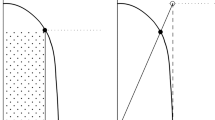Abstract
David Gale (Math Intell 15:48–52, 1993) was perhaps the first to suggest that there is a difference between cake and pie cutting. A cake can be viewed as a rectangle valued along its horizontal axis, and a pie as a disk valued along its circumference. We will use vertical, parallel cuts to divide a cake into pieces, and radial cuts from the center to divide a pie into wedge-shaped pieces. We restrict our attention to allocations that use the minimal number of cuts necessary to divide cakes or pies. In extending the definition of envy-freeness to unequal entitlements, we provide a counterexample to show that a cake cannot necessarily be divided into a proportional allocation of ratio p:1−p between two players where one player receives p of the cake according to her measure and the other receives 1−p of the cake according to his measure. In constrast, for pie, we prove that an efficient, envy-free, proportional allocation exists for two players. The former can be explained in terms of the Universal Chord Theorem, whereas the latter is proved by another result on chords. We provide procedures that induce two risk-averse players to reveal their preferences truthfully to achieve proportional allocations. We demonstrate that, in general, proportional, envy-free, and efficient allocations that use a minimal number of cuts may fail to exist for more than two players.
Similar content being viewed by others
References
Barbanel JB (2005). The geometry of efficient fair division. Cambridge University Press, New York
Barbanel JB and Brams SJ (2004). Cake division with minimal cuts: envy-free procedures for three persons, four persons and beyond. Math Soc Sci 48: 251–269
Barbanel JB, Brams SJ, Stromquist W (2007) Cutting a pie is not a piece of cake. Preprint
Boas RP (1960). A primer of real functions. Mathematical Association of America, Washington, DC
Brams SJ and Taylor AD (1996). Fair division: from cake-cutting to dispute resolution. Cambridge University Press, New York
Brams SJ, Jones MA and Klamler C (2006). Better ways to cut a cake. Notices Am Math Soc 53: 1314–1321
Gale D (1993). Mathematical entertainments. Math Intell 15: 48–52
Jones MA (2002). Equitable, envy-free and efficient cake cutting for two people and its application to divisible goods. Math Mag 75: 275–283
Levy P (1934). Sur une generalisation du Théorème de Rolle. CR Acad Sci Paris 198: 424–425
Robertson J and Webb W (1998). Cake-cutting algorithms: be fair if you can. AK Peters, Natick
Stromquist W (1980). How to cut a cake fairly. Am Math Mon 88: 640–644
Thomson W (2007). Children crying at birthday parties. Why?. Econ Theory 31: 501–521
Author information
Authors and Affiliations
Corresponding author
Rights and permissions
About this article
Cite this article
Brams, S.J., Jones, M.A. & Klamler, C. Proportional pie-cutting. Int J Game Theory 36, 353–367 (2008). https://doi.org/10.1007/s00182-007-0108-z
Accepted:
Published:
Issue Date:
DOI: https://doi.org/10.1007/s00182-007-0108-z




